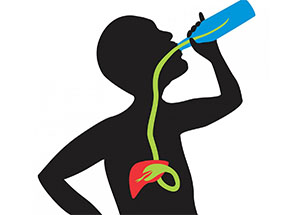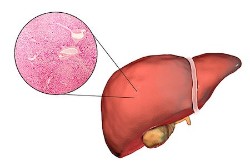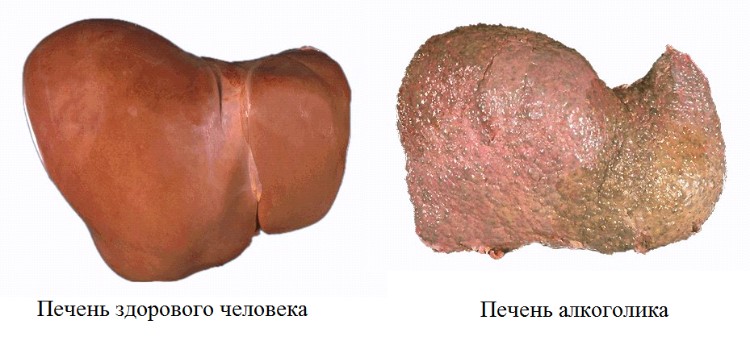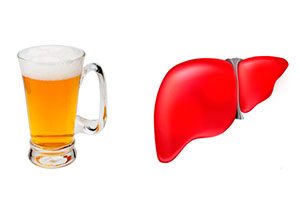How alcohol affects the human liver — 6 proven effects
 According to research, alcohol consumption is one of the main (but preventable) causes of death worldwide, and it is primarily associated with liver disease.
According to research, alcohol consumption is one of the main (but preventable) causes of death worldwide, and it is primarily associated with liver disease.
According to statistics 20-30% of people who abuse alcohol develop cirrhosis, and about 15% of people develop hepatocellular carcinoma (colloquially liver cancer). In addition, alcohol intake, affecting liver cells, increases the risk of fatty disease, hepatitis and many other pathologies.
But not many people know exactly what happens after a person drinks alcohol. And because of this, a lot of different myths have arisen regarding the benefits and harms of alcohol.
For example, many people believe that drinking a glass of dry white wine every day, on the contrary, strengthens the body, especially the cardiovascular system. Others argue that even a couple of drops of alcohol, which are part of medicinal tinctures, worsen liver function, therefore, such drugs should be abandoned.
What happens specifically to the liver when drinking alcoholic beverages? How does alcohol affect it and is there a safe dose? All the answers are in this article.
Content
The mechanism of alcohol's effect on the liver
The first thing to do is to figure out what reactions alcohol triggers in the body, how it transforms, how long it lasts and when it is excreted. This happens in the following sequence:

- So, there is ethyl alcohol in any alcoholic drink. It is a flammable solvent, in the environment of which bacteria and viruses cannot live (most of them, but not all).
- When ingested, any alcoholic beverage comes into contact with the mucous membrane, partially dissolving it. At the same time, ethyl alcohol molecules enter the bloodstream, soaking through the walls of the stomach.
- Next, alcohol, diluted with gastric juice and food, enters the small and large intestines, from where they begin to enter the circulatory system faster.
- However, alcohol penetrates not only into blood vessels. There is also the concept of "general diffusion". That is, alcohol gets into the lymph and even into the subcutaneous tissue. In all those systems of the body where there is water (which forms the basis of the liquid, of which 70% consists of a person).
- Thus, alcohol is carried by the circulatory system to almost all organs. By alcohol entering the brain - the same intoxication occurs due to the neurotoxic effect of ethyl alcohol molecules. At the same moment, the liver begins to actively neutralize alcohol – it is with its help that the blood is "purified".
- Then ethanol is transformed to acetic aldehyde, later to acetic acid. And only after that, the acid spreads throughout the body and is synthesized in tissues to carbon dioxide and water.
Both ethanol and acetic aldehyde are the strongest toxins. They stimulate the oxidation of cells, provoke the adhesion of red blood cells. If the liver does not get rid of these poisons in a timely manner, then this will inevitably lead to death.
How long does it take for the liver to neutralize ethanol? An average of 20 hours. The final figure depends on the amount of alcohol consumed, as well as the water-salt balance, since the body actively uses water and potassium compounds in the process of removing toxins. Accordingly, the more a person drinks liquids, the faster his body will cope with alcohol.
What happens directly during alcohol consumption? The liver temporarily accumulates toxins derived from ethanol (the same acetic aldehyde), inflammation occurs, an increase in liver size – all this is necessary to stimulate blood flow and accelerate the withdrawal of alcohol end products.
And it is because of this that the liver can hurt when alcohol is abused. Naturally, the cells of the organ itself are also damaged by the action of toxins, oxidized and destroyed. And this happens even if you drink literally 50 grams of weak wine – the above chain of biochemical reactions is still triggered, the liver comes into contact with toxins.
6 consequences of regular use
Regular alcohol consumption has the following effect on the liver:

- Destruction of hepatocytes. They are the main cells of the organ parenchyma, where a whole range of biochemical processes with the neutralization of toxins take place. Reducing the number of active hepatocytes reduces the efficiency of the organ, including slowing down the withdrawal of ethyl alcohol derivatives. When there are very few of them left, cirrhosis develops, since the liver simply does not have time to remove all the toxins and they gradually destroy the organ.
- Bile production slows down. Many bile ducts are completely destroyed at the same time. All this negatively affects the work of the gastrointestinal tract in the future, because the body loses the ability to digest and digest food normally.
- Destroyed liver tissues are replaced by connective and adipose tissue. It also reduces the efficiency of the organ, increases the risk of impaired hepatic blood flow, as the forming tumors can simply squeeze blood vessels .
- The organ increases in volume (in medicine it is called "hepatomegaly"). With minor deviations from the norm, this effect has no negative consequences. But in the future there is a risk of displacement of the abdominal organs. A change of position can also cause compression of blood vessels.
- The natural protection of the liver from infections is reduced. Those who drink alcohol frequently have a much higher risk of hepatitis infection. For others, contact with the virus does not always end with the transition of the disease to the acute stage.
- Stones form in the bile ducts. Regular alcohol consumption leads to destabilization of the water-salt balance in the body, in which blood there is an increased concentration of sodium. Namely, sodium compounds stimulate the formation of gallstones (concretions).


Conditionally safe dose
How much ethyl alcohol can you consume without irreversible harm? Doctors conditionally allocate a "safe dose" of alcohol, which is commonly called a "drink". This classification was introduced by British scientists, but now it is used almost all over the world. One such "drink" is a conditionally safe portion of alcohol, the body will cope with the neutralization of which without any negative consequences.
 Such a serving is equivalent to:
Such a serving is equivalent to:
- 330 milliliters of beer;
- 150 ml of medium strength wine;
- 45 milliliters of any strong alcohol (over 40% alcohol content).
It is believed that twice drinking "drink" during the week is safe for the body and, in particular, does not harm the liver. But this is important for the average healthy man who does not have chronic liver and cardiovascular diseases. For women, this portion is 30% lower.
7 Rules for minimizing harm
But in order to minimize harm and protect the liver when taking higher doses of alcohol, it is recommended to follow the following tips:
- Take activated charcoal. 10 – 15 tablets for prevention before the planned feast will reduce the load on the liver by 50-60%.
- You should not drink alcohol. Carbonated drinks are especially "harmful" in this regard. Drinking alcohol increases the volume of the alcohol–containing mixture in the stomach, respectively, it will take more time for the body to "process" it.
- Do not drink on an "empty stomach". Even better is to have a hearty meal beforehand. The fat in the food will literally envelop the mucous membrane of the stomach, intestines, thereby reducing the amount of alcohol that gets into the blood.
- Pre-drink a small amount of alcohol. That is, take 20-30 ml of alcohol a couple of hours before the planned feast. This will not have a negative effect on the liver, but it will prepare it for the bile run. Accordingly, the removal of toxins will be performed somewhat faster.
- It is better to take vodka from strong drinks. It is considered the most "safe" alcohol with a high content of ethyl alcohol. This is explained by the small volume and the absence of third-party impurities, which slow down and complicate the neutralization of toxins.
- Take a break between repeated alcohol intake. It is recommended to maintain an interval of at least 40 minutes – during this time, the liver will have time to neutralize a significant amount of previously drunk alcohol.
- Drink only high-quality alcohol. If the correct production technology is followed, a huge list of toxic substances formed during fermentation is removed from alcoholic beverages (alcohol is still extracted by this method). In alcoholic beverages made in "underground conditions", no one carries out such filtration. Moreover, heavy metal impurities are often found in their composition &8212; this indicates not a low-quality primary base used for the manufacture of alcohol. Therefore, they are more likely to be poisoned.
And one more piece of advice is to temporarily give up nicotine (at the moment when there is alcohol in the body). You should not smoke a few hours before the planned intake of alcohol, as well as before its complete withdrawal from the body (that is, during the day). A mixture of ethanol with smoky gas leads to accelerated adhesion of red blood cells – they are also subsequently excreted and neutralized through the liver. But if there are too many of them in the circulatory system, it can provoke thrombosis of the feeding vessels .
Rating &171;harmfulness&187; — review of 9 drinks
Many people are interested in what is more harmful: beer, vodka or wine with cognac. According to the degree of "severity" for the liver, alcoholic beverages are arranged in the following order, from less harmful to more:

- Vodka. Is considered the most "safe" alcoholic beverage, since there are no third-party impurities in the composition, in addition to ethanol, which are also perceived by the body as toxins. In addition, modern production methods of this drink imply the almost complete removal of fusel oils from it, which are even more harmful to the liver than ethyl alcohol.
- Dry red wine. is considered the purest "wine" alcohol with a minimum content of impurities. In addition, it contains fructose, which also accelerates the withdrawal of alcohol from the body. All this information is relevant only for high-quality dry red wine, but the popular "packaged", as a rule, has nothing to do with real wine.
- Gin. In its composition it is very similar to vodka. But the drink is very strong, so a fairly large amount of ethanol immediately enters the body. It is recommended to drink very small doses, literally 30 milliliters, without drinking.
- Cognac. Is an analogue of vodka, but with a base in the form of malt or vegetable extract. But there are also such variations of cognac that the liver perceives very poorly – the composition of different manufacturers differs dramatically.
- Whiskey. Rum can also be added here (they are very similar in composition). They contain a large number of additives, oils that negatively affect the liver. The worst solution is to mix these drinks with something less strong. An increase in the volume of alcohol consumed is extremely negatively "perceived" by the liver, in the morning a hangover syndrome is provided.
- Beer. The main drawback of this drink is the presence of carbon dioxide in the composition, which causes ethanol to enter the blood faster. At the same time, there is hoppy malt in beer – because of it, the fermentation process is activated, which also releases several groups of toxins. Learn more about the effects of beer on the liver here →
- Absinthe. In its composition, in addition to ethanol, fusel oils, dyes and vegetable toxins are often found (from the same wormwood, for example). For the liver, it turns out to be a kind of "double whammy". If you really drink absinthe, then in very small portions and no more than 2 times a month.
- Champagne. The main disadvantage of this drink is the high degree of carbonation, which contributes to the very rapid penetration of ethanol into the blood (about 98% of what was drunk enters the circulatory system within 30 minutes). It is clearly not worth abusing champagne.
- Counterfeit alcohol, homemade moonshine, etc . They contain a high content of fusel oils. Even a small portion of them can be fatal. That is why moonshine and other drinks that are made at home are better not to use at all.
Can alcohol be safe at all? If you follow the recommendations for "drinks", then the danger to the liver from drinking alcoholic beverages will still be, but insignificant. That is, the "harmless dose" is calculated in such a way that the probability of any complications with alcohol consumption is minimal.
It is worth mentioning the "burning" of alcohol – now this practice of drinking alcohol is widespread. It is recommended to abandon this, since heated alcohol also enters the bloodstream faster than chilled alcohol. In addition, with such alcohol consumption, you can banally burn the nasopharynx, esophagus. Such cases are well known to doctors.
Dry red wine is useful: myth or truth?
Even some groups of scientists claim that in small quantities, dry red wine has more beneficial effects on the body than negative ones. However, Russian scientists disagree with such statements. Each of the parties has real arguments to support their statements. If both opinions are taken into account, then it can be argued:

- Dry red wine is really improves performance of the cardiovascular system, slightly dilutes the blood and dilates blood vessels . But only if you consume a drink in limited quantities (no more than 70 milliliters per day, no more than 2 times a week).
- Alcohol contained in red dry wine destroys liver cells. Again, ethyl alcohol is not different, for the body it is the same substance, which is a powerful toxin.
But California scientists recently conducted additional research. According to him, all those who at least occasionally consume dry red wine in moderate amounts suffer from steatohepatitis 2 times less often than others. However, scientists have not been able to explain this phenomenon. It is believed that this effect is due to the presence of special essential combinations in the composition of red wine. But all these are just predispositions, scientists could not name any exact facts.
Accordingly, no one has yet managed to prove that grape wine is useful for the liver. Therefore, the statement that it is useful should be regarded precisely as a myth that has nothing to do with reality. But research in this direction continues, it is possible that in the future scientists will make new discoveries.
Interesting video
And now we invite you to familiarize yourself with the video:
Conclusion
In total, alcohol, even in small quantities, harms the liver, since when it is neutralized, toxins are formed, upon contact with which the process of destruction of organic matter is activated (due to oxidation). And this effect persists even if you drink literally 25-30 milliliters of vodka.





